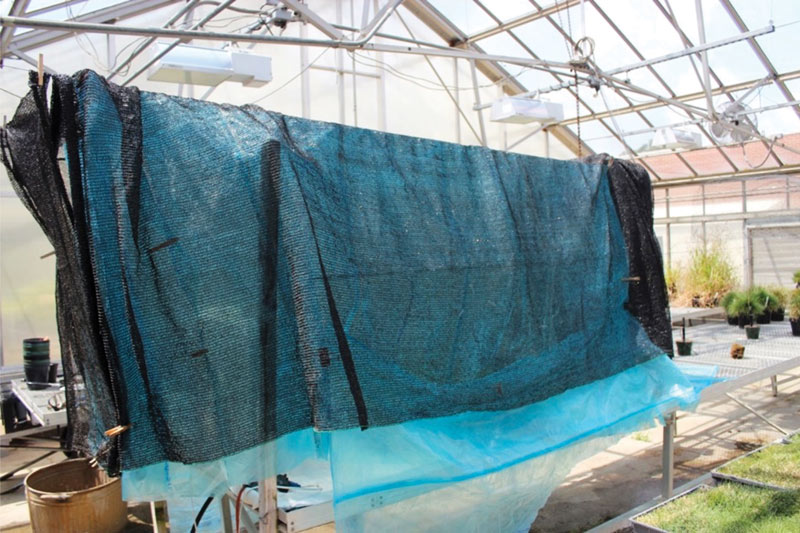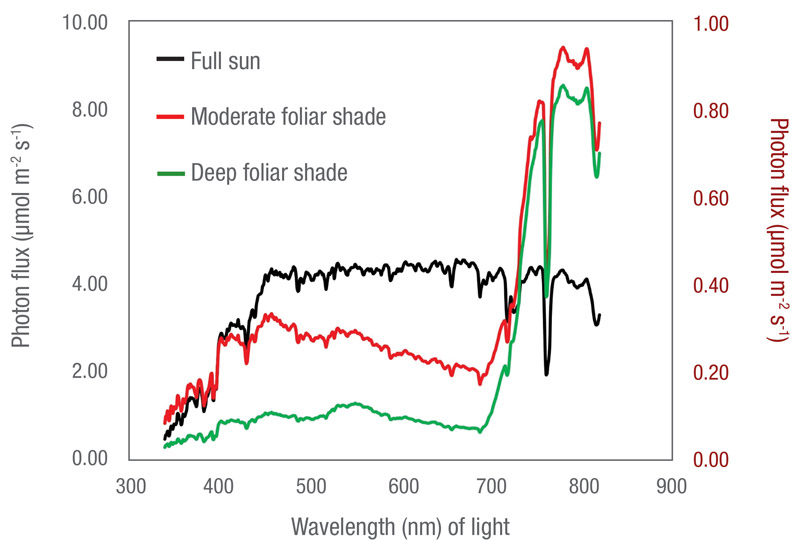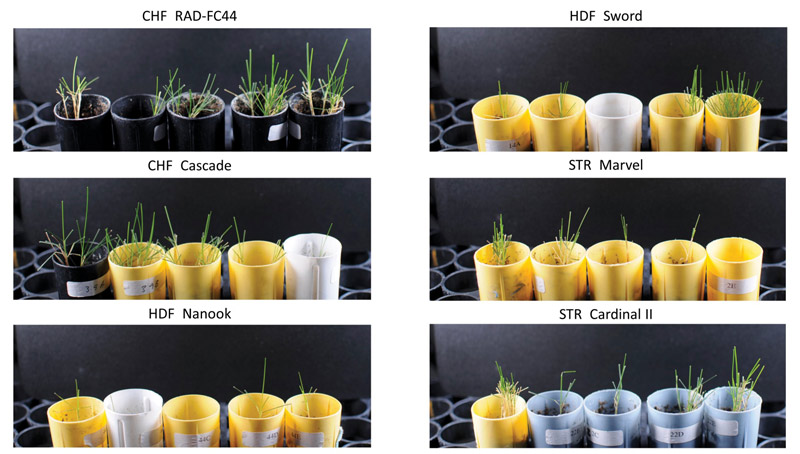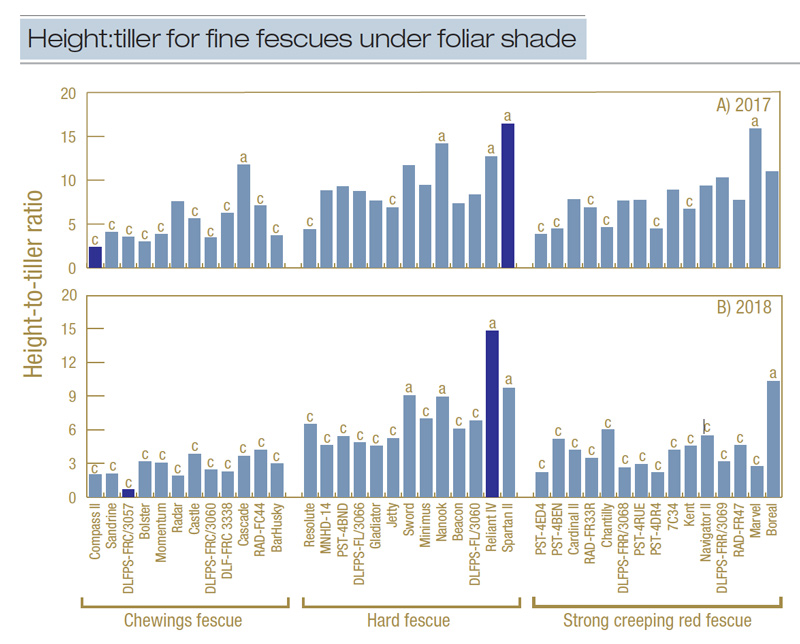
A tent was used to simulate foliar shade for experiments in 2017 and 2018. The blue polyethylene plastic reduced both light intensity and the R:FR within the shade tent, and the black shade cloth on top further reduced light intensity within the shade tent. Photos by Dominic Petrella
Shade is more complicated than most people imagine. It can come from multiple sources, including structures, such as houses and stadiums (structural shade), and from neighboring/overhead foliage, such as trees and shrubs (foliar shade). All types of shade reduce light intensity (light quantity), but different types of shade affect the distribution of specific wavelengths of light and therefore have different light quality (see Figure 1, below).
A specific feature of foliar shade is a greater reduction in red light (660 nanometers) relative to far-red light (730 nanometers) (6, 8). This differential reduction in red to far-red light results in a reduction in the red to far-red (R:FR) ratio, which is normally around 1.0 in full sun and can be as low as 0.10 in deeply shaded areas where turf is growing.
Plants use the R:FR as a means to sense their environment, and reductions in the R:FR will lead to specific changes in growth and development termed “shade-avoidance responses” or “shade-avoidance syndrome” (1, 8). The most obvious change from shade-avoidance responses is decreased tillering, which leads to reductions in turf density and greater leaf elongation. Turfgrasses/plants that are more shade-tolerant will exhibit responses contrary to shade-avoidance responses: more tillering, higher density and reduced leaf elongation. Reductions in the R:FR affect turfgrasses beyond reductions in light intensity alone (2, 5, 9), and looking only at turfgrass tolerance to reduced light intensity will not tell the entire story of the turfgrass’s potential shade tolerance.

Figure 1. Spectral energy distribution of solar radiation under full sun, moderate and deep foliar shade conditions. Notice that the left and right axes are different. The left y-axis applies to the light intensity for full sun, and the right y-axis applies to the two shade environments. Note the 10-degree decrease in magnitude for the shade environments. Under the two shade environments, there is a greater reduction in red light around 660 nanometers vs. far-red light, around 730 nanometers. This specific reduction in the R:FR ratio is perceived by plants and leads to shade-avoidance responses.
Research has shown variation in shade tolerance among cool-season turfgrasses, with supine bluegrass (Poa supina Schrad.), rough bluegrass (Poa trivialis L.), tall fescue (Schedonorus arundinaceus Schreb.) and the fine fescues (Festuca species) being the most shade-tolerant (3, 4, 7). Of the fine fescues, Chewings fescue (Festuca rubra subspecies commutata Gaudin) has been listed as the best-performing cool-season turfgrass for shade, and strong creeping red (F. rubra subspecies rubra Gaudin) and hard fescue (F. brevipila Tracey) have been cited as “very good” (3).
Researchers have, however, provided mixed reports on fine fescue shade tolerance and whether specific species have good shade tolerance (4). These mixed reports may be due to large amounts of variation in field experiments, or the use of shade treatments that did not reduce the R:FR (no change in light quality). With this in mind, the objective of our research was to evaluate variation for shade-avoidance responses and shade tolerance in Chewings, hard and strong creeping red fescue under simulated foliar shade that reduced both light intensity and the R:FR.
Methods
In 2017 and 2018, we evaluated the growth of 12 Chewings fescue, 13 hard fescue and 15 strong creeping red fescue cultivars and selections in the greenhouse under a tent that simulated foliar shade and reduced light intensity and the R:FR (see photo above). We also ran a second experiment in which the plants were not shaded under full sun, to examine whether potentially poor-performing entries were simply poor-performing.
For each cultivar, we examined five distinct genotypes each year under both simulated foliar shade and full-sun conditions. Each of these was started from single seeds in order to help us better understand genetic variation for shade tolerance in each cultivar. This helped us better determine how homogenous a given cultivar would perform when seeded as a turf stand as well.
We measured turfgrass height, counted the number of tillers, quantified chlorophylls, measured leaf tissue biomass and determined the specific leaf area (a proxy for leaf thickness). We also calculated a ratio of plant height to the number of tillers at the end of the three-month experiment. Plants with a large height-to-tiller ratio are taller than they are dense, and a height-to-tiller ratio less than 1.0 indicates there are more tillers relative to the plant height.
Results and discussion
Plant height
In both years, Chewings and hard fescue were significantly shorter than strong creeping red fescue in sun. In shade, Chewings fescue was significantly shorter than both other species in 2017, and in 2018, both Chewings and hard fescue were significantly shorter than strong creeping red fescue (see Table 1).

The top-performing fine fescue entries from 2017 mostly lacked shade-avoidance responses and were shade-tolerant. Though these cultivars/selections were, overall, more shade-tolerant, not all of the plants we evaluated from each cultivar could be classified as shade-tolerant. All plants were trimmed before the photos were taken.

The fine fescue entries from 2017 that had the worst performance were shade-intolerant or exhibited greater shade-avoidance responses. All plants were trimmed before the photos were taken.
Number of tillers
In 2017, Chewings fescue had more tillers than hard and strong creeping red fescue in sun, but in 2018, hard fescue had significantly more tillers than both other species in sun. In both years under shade, Chewings and strong creeping red fescue had more tillers than hard fescue (Table 1). In 2017, Chewings fescue cultivar Radar and strong creeping red fescue Boreal had the most tillers under shade, while hard fescue Nanook had the least. In 2018, Chewings fescue DLFPS-FRC/3057 had the most tillers under shade, while hard fescues Nanook and Reliant IV had the least.
Height-to-tiller ratio
Strong creeping red fescue had the largest height-to-tiller ratio in both years under sun. In shade, Chewings fescue had a significantly lower ratio compared with both other species, and hard fescue had the largest ratio in both years (Table 1). The largest height-to-tiller ratios were for the hard fescues Spartan II in 2017 and Reliant IV in 2018, and the smallest ratios were for the Chewings fescues Compass II in 2017 and DLFPS-FRC/3057 in 2018 (Figure 2, below).

Figure 2. The height-to-tiller ratio for fine fescues under simulated foliar shade in 2017 and 2018. Dark blue bars represent cultivars with the highest or lowest height-to-tiller ratio. a = significantly different from the cultivar with the lowest ratio, not from the highest mean; c = significantly different from the cultivar with the highest ratio, not from the lowest mean; no letter = not significantly different from the cultivar with the highest or the lowest ratio.
Biomass
Hard fescues under sun accumulated significantly more biomass compared with both of the other species in 2017 and 2018. However, under shade, both Chewings and strong creeping red fescues accumulated more biomass than hard fescues in 2017 and 2018 (Table 1).
Diversity within cultivars
Using these results, we were able to classify individual plants as: 1) shade-avoidant (plants that had shade-avoidance responses), 2) slow-growing under shade, 3) shade-intolerant, or 4) more shade-tolerant and lacking shade-avoidance responses. Chewings fescues made up 48% of the plants that lacked shade-avoidance responses in 2017 and 58% in 2018, and they were more shade-tolerant in both years. Hard fescues made up 53% of shade-intolerant plants in 2017 and 83% in 2018. Only the Chewings fescue cultivars Radar, Compass II, DLFPS-FRC/3057 and DLFPS-FRC/3060 and the strong creeping red fescue PST-4DR4 had greater than 40% of plants that lacked shade-avoidance responses or were shade-tolerant in both years (Table 2). Gladiator was the only hard fescue cultivar that had shade-tolerant plants (Table 2). In some cultivars, a majority of genotypes were shade-tolerant, but other cultivars had a mixture of shade-avoidant and shade-tolerant genotypes; DLFPS-FRC/3057 is a perfect example of this (Table 2). This lack of homogeneity may help explain the patchiness generally observed under shade — some individual plants will perform well, but others in the same vicinity may not, leading to distinct patches.
Editor’s note: GCM has published ample recent research on fine fescue use on golf courses. Find clarified taxonomic classification, establishment and management recommendations, information on biotic and abiotic stresses, and more.
Conclusions
The fine fescue species we evaluated responded differently to the simulated foliar shade treatment. In particular, hard fescues had some of the most tillers and greatest biomass in sun, and the least biomass and tillers in shade. On the other hand, Chewings and strong creeping red fescues did not exhibit this dramatic shift in growth, signifying a greater level of shade intolerance and/or shade-avoidance responses in hard fescue. The large reduction in tillering in hard fescues under foliar shade compared with both Chewings and strong creeping red fescues is the primary reason this species lacked an acceptable amount of shade tolerance.
Cultivars within the same species performed very differently, and even genotypes of the same cultivar performed very differently under shade. This variation within the fine fescues indicates there is further potential for selecting fine fescues (and other turfgrass species beyond the fine fescues) for improved responses to shade. Turfgrass breeders and other turfgrass researchers should more often consider decreased light quality and reductions in the R:FR specifically found under foliar shade when evaluating new germplasm and management practices for shade-affected sites.
Acknowledgments
This project was supported by the National Institute of Food and Agriculture, USDA, Specialty Crops Research Initiative under Award No. 2017-51181-27222, and by the Minnesota State Agricultural Experiment Station Project No. 21-051. This research was originally published by the authors in 2020 as “Variation in fine fescue taxa response to simulated foliar shade” in the journal Crop Science 60(6):3377-3394 (https://doi.org/10.1002/csc2.20279).
The research says ...
- Forty fine fescue cultivars and selections of Chewings, hard, and strong creeping red fescue were tested for their responses to full sun and simulated foliage shade.
- Individual plants were classified as shade-avoidant, slow-growing under shade, shade-intolerant, or more shade-tolerant and lacking shade-avoidance responses.
- Chewings fescues were more shade-tolerant, and hard fescues showed a higher level of shade intolerance and shade avoidance than Chewings and strong creeping red fescues.
- The wide variation among and within species and cultivars of fine fescues offers plant breeders opportunities for developing shade-tolerant varieties.
Literature cited
- Casal, J.J. 2013. Photoreceptor signaling networks in plant responses to shade. Annual Review of Plant Biology 64:403-427 (https://doi.org/10.1146/annurev-arplant-050312-120221).
- Casal, J.J., V.A. Deregibus and R.A. Sanchez. 1985. Variations in tiller dynamics and morphology in Lolium multiflorum Lam. vegetative and reproductive plants as affected by differences in red/far-red irradiation. Annals of Botany 56(4):553-559 (https://doi.org/10.1093/oxfordjournals.aob.a087040).
- Fry, J.D., and B. Huang. 2004. Shade. Pages 111-124. In: J.D. Fry and B. Huang, editors. Applied turfgrass science and physiology. John Wiley & Sons, Hoboken, N.J.
- Gardner, D.S., and R.M. Goss. 2013. Management of turfgrass in shade. Pages 219-247. In: J.C. Stier, B.P. Horgan and S.A. Bonos, editors. Turfgrass: Biology, use, and management. ASA, CSSA and SSSA, Madison, Wis.
- Gautier, H., C. Varlet-Grancher and L. Hazard. 1999. Tillering responses to the light environment and to defoliation in populations of perennial ryegrass (Lolium perenne L.) selected for contrasting leaf length. Annals of Botany 83(4):423-429 (https://doi.org/10.1006/anbo.1998.0840).
- Holmes, M.G., and H. Smith. 1977. The function of phytochrome in the natural environment—II. The influence of vegetation canopies on spectral energy distribution of natural daylight. Photochemistry and Photobiology 25(6):539-545 (https://doi.org/10.1111/j.1751-1097.1977.tb09125.x).
- Leinauer, B., H. Schulz, A. Bar and A. Huber. 1997. Poa supina Schrad.: A new species for turf. Pages 345-351. In: Proceedings of the 8th International Turfgrass Research Conference, Sydney, Australia. July 20-26. ASA, CSSA and SSSA, Madison, Wis.
- Smith, H. 1982. Light quality, photoperception, and plant strategy. Annual Review of Plant Physiology 33:481-518 (https://doi.org/10.1146/annurev.pp.33.060182.002405).
- Wherley, B.G., D.S. Gardner and J.D. Metzger. 2005. Tall fescue photomorphogenesis as influenced by changes in the spectral composition and light intensity. Crop Science 45(2):562-568 (https://doi.org/10.2135/cropsci2005.0562).
Dominic Petrella is a researcher and Eric Watkins is a professor in the Department of Horticultural Science at the University of Minnesota, St. Paul, Minn.